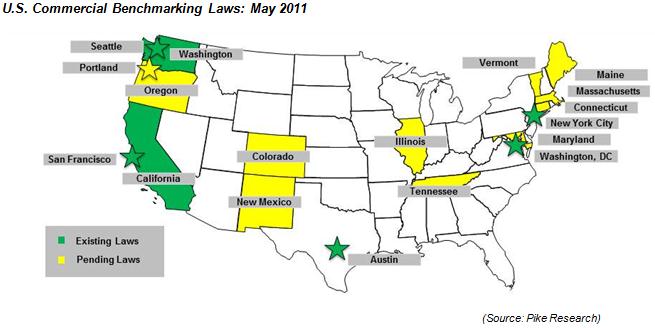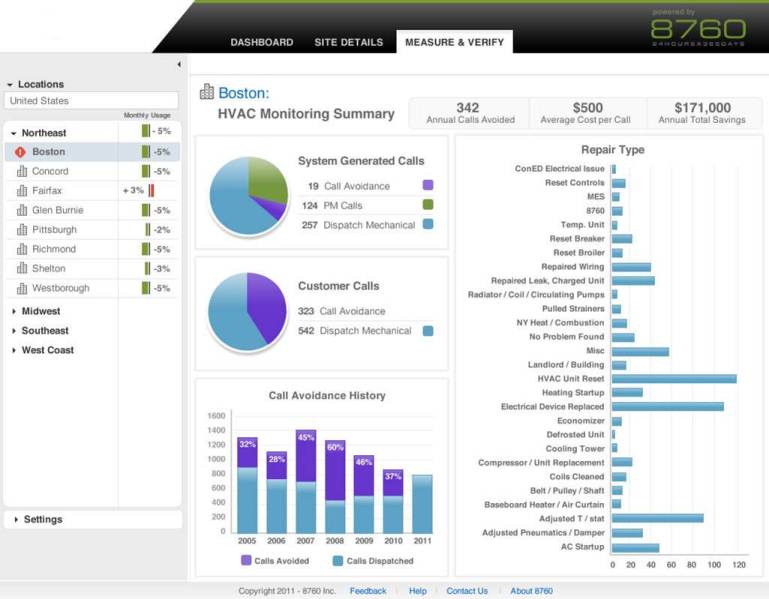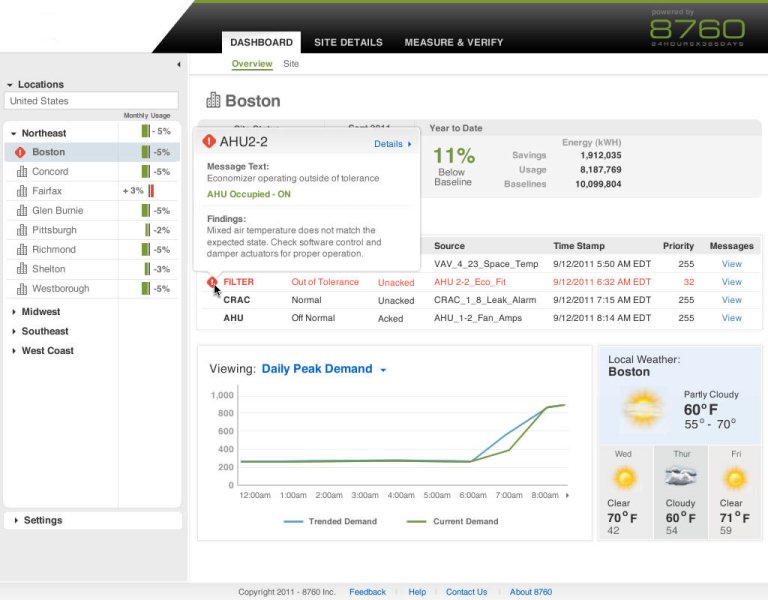Smart Buildings at Their Best
|
April 2012 |
[an error occurred while processing this directive] |
|
Open and
Honest
Smart Buildings at Their Best |
| Articles |
| Interviews |
| Releases |
| New Products |
| Reviews |
| [an error occurred while processing this directive] |
| Editorial |
| Events |
| Sponsors |
| Site Search |
| Newsletters |
| [an error occurred while processing this directive] |
| Archives |
| Past Issues |
| Home |
| Editors |
| eDucation |
| [an error occurred while processing this directive] |
| Training |
| Links |
| Software |
| Subscribe |
| [an error occurred while processing this directive] |
Our country has been
spoiled with the notion that cheap abundant power
is a given right. For generations, we have told our children:
“money does not grow on trees.” We should be conveying the same
message about electricity. Peak demand for electricity is a
mounting problem for utility companies as weather conditions prove to
be extreme. Customers pay more for power in the absence of peak
demand mitigation. Appliances may be operating more efficiently
through programs such as Energy Star, but the use of plug in devices
has significantly increased energy usage. Building performance in
general is pretty poor. Energy reduction is a preventative
measure for energy providers and customers alike. With better
information comes better decision making and that is where the Smart
Building begins.
When referring to energy and cost savings opportunities, the U.S.
Department of Energy reports that commercial building stock is
responsible for 18% of primary energy consumption in the U.S. as well
as use of 36% of the nation’s electricity in 2006.1
To
capture those opportunities, our government is legislating mandatory
benchmarking and will soon be hitting every state and town in the
United States. Capturing these metrics will help determine how
blackouts and brownouts may be avoided. With Oregon, Connecticut,
Massachusetts, Vermont, Maine, Colorado, New Mexico, Illinois,
Tennessee, and Maryland on the way, cities like Washington, D.C., New
York City, San Francisco, Austin, and the states of California and
Washington are already requiring building owners to measure and
publicize their energy usage to prospective buyers and renters.
Focusing initially on 50,000 SF commercial buildings or larger, these
target locations already requiring benchmarking will extend to
non-residential and multi-family residential buildings greater than
10,000 SF this month.2

What
does that mean for building managers? Gear up for sweeping
change that will be coming
down the pike. Proactively measuring
and improving energy management strategies now will bring forth
profitable results before it is mandated.
Smart Building technologies and services are constantly changing and
that is precisely why our model enables our customers to remain
flexible. Our commitment to delivering a fully open environment
enables them to make impactful decisions today that can be readily
supported over time. Our goal is to continuously provide our
customers with the ability to sustainably manage the lifecycle of
infrastructure, data, information, and knowledge of their assets in
real time.
My first experience with proprietary building system architecture and
its high cost of ownership occurred from the mid-80’s through the
mid-90’s at New York University where I held Facilities Engineering and
Facilities Director positions. I inherited a vertical
transportation system of over 200 elevators that were in need of major
refurbishment due to age and neglect. While looking at elevator
maintenance contracts for over 50 facilities I came across a new
dormitory that NYU had just completed, then being serviced by
Schindler. The monthly costs to maintain the newest elevators on
campus were four times higher than the average cost for all other
buildings! After performing some due diligence, I found out that
the controller technology specified and approved by the design
engineers included proprietary Schindler controllers. No other company
could service the elevators in this facility. We were being held
hostage at four times the cost with no other option. After an
exhaustive search, I found a company that developed a truly open
architecture for elevator controls: Motion Control Engineering
(mceinc.com). We specified MCE elevator controllers for many
subsequent projects, ensuring that quality, price and service would
always be priority, saving significant capital and operational dollars
along the way.
8760, Inc.’s larger competitors claim to be open as we are. To
explore the term “open”, it is best to first look to the meaning of
open by one of the big guys.
[an error occurred while processing this directive]
One proprietary
manufacturer states: “Open
means options -
providing a system that uses only a single standard protocol doesn’t
provide options. Having options provides a system with the
flexibility to provide solutions
to specific customer needs…. Adding
vendors always complicates the operation of a facility. Unless a
customer has a specific tangible goal in mind, the costs may outweigh
the benefits of bringing more vendors on site.”3 This
statement tells it all. Since these manufacturers do not embrace
a truly open environment, they view options in a product centric way,
which means multiple vendors supporting multiple systems. Truly
open means ONE platform that could be supported by whatever vendor or
vendors the customer chooses.
As industry trends show, end users are becoming more
educated. The Smart Building market will depend on the
expertise of systems integrators that possess a wide and deep
understanding of how to integrate the many disparate legacy systems we
encounter, ultimately onto a portfolio level platform.
As a systems integrator, 8760, Inc. offers complete control and
monitoring solutions that include building automation, energy
management, and decision support through a fully integrated
platform. We deliver effective energy and facilities
management solutions utilizing cutting edge technologies guaranteeing
optimal and measured performance 24x7x365.
When we
began our business as Automated Building Controls back in 2002,
we adopted LonWorks protocol because of their open environment and
believed that is where the market was headed. LonWorks’ ground-up
design is implemented with communication at the device level.
Representing 82% of the building controls market world-wide, LonWorks
promotes the use of logical routers for data transmission without
gateways. It is intended for interoperability of sub-systems,
such as lighting, access, and security, not simply HVAC. The
growth of our ability to study energy usage is directly proportional to
our customers’ need for additional services and incorporation of other
functionalities. The more open we are, the easier it is for us to
remain flexible as innovators create new products and end users crave
more
options.

On the
energy side we can study kWh down to the device level. On
the facility side we can study, for instance, the performance of
Variable Air Volume (VAV) unit on individual floors of a building.
Granularity is what we are after because the more we are able to study
remotely, the less our customers will have to physically expend
resources at each of their buildings. We track how our diagnostic
efforts result in HVAC service calls avoided over any period of time
and have demonstrated for our customers a significant reduction in
costs associated with gas, emissions, time, and fees for service tech
visits. Analytics gleaned from monitoring keep a building
operating within the tolerance of how it was designed, whether existing
or new.

What are business trends in relation to greening building stock? Green Biz’s State of Green Business Report 2012 concludes that companies see emissions as, “a byproduct that has no value to the company or its customers, a proxy for inefficiency.” By equating consumption to costs, company decision makers are already attuned to integrating financial and environmental sustainability.
In fact, former Vice President and staunch advocate for renewable
energy, Al Gore recently co-authored a Manifesto for Sustainable
Capitalism with David Blood, former Goldman Sachs Asset Management CEO,
asking the question “Why does an absence of sustainability not damage
companies, investors and society at large?”4 They
blame the
short term vision of volatile investors on our unprecedented economic
income inequality. Proponents of integrated reporting, Gore and
Blood only see positive value generated from companies integrating
environmental, social, and governance metrics into their
financials. And this is something we at 8760, Inc. have realized
and are setting into action. We have started compiling a new
monthly automation newsletter for our client, a Fortune 50 financial
institution, prefaced with a summary highlighting observed operational
metrics. Any repair or service event is tracked from inception to
completion, delivering 100% accountability. This provides key
feedback necessary for actionable decisions. CEO’s and CFO’s are
accustomed to synthesizing numbers and statistics yet, in addition to
their positive ROI figures, they crave a most comprehensive summary of
the performance efficiencies on an operational level as well as the
benefits their behavior modification offers society. Through our
reports, we demonstrate to our client how their actions are impacting
the planet for the better.
The best advice I have for organizational leaders and building owners
is this: Get started measuring your energy usage now and you will be
ahead of the game. To be a strong leader, take the initiative to
understand your facility’s operations inside and out. This will
reveal not only economic and environmental waste, but human
redundancies as well. We have found that when our customers have
their building stock’s functional information at their disposal, then
and only then are they capable of making the most informed decisions
from the Boiler Room to the
Boardroom.
___________________
1
“Building Technologies Program.” Energy
Efficiency & Renewable Energy, 24th Jan 2011, Web. 23 Feb
2012
2 Bloom, Eric “City of Seattle Joins Commercial
Benchmarking Movement.” Pike
Research Online, 18th May 2011, Web. 23 Feb 2012
3Open System Technology Power Point Presentation, www.controlmanagement.com/Demos/OpenSysTech.ppt
4Gore, Al, and David Blood. "A Manifesto for Sustainable
Capitalism: How Business can embrace environmental, social and
governance metrics." Wall Street
Journal. Web. 16 Feb. 2012. <http://www.generationim.com/media/pdf-wsj-manifesto-sustainable-capitalism-14-12-11.pdf>
About the Author
Len
Pisano - Prior
to joining 8760, Inc. as partner and CEO in 2008, Len amassed
rich experience in Building Management systems during a 10 year
career at New York University as Facilities Engineer and eventually
Director of Facilities Management. His entrepreneurial appetite
led him to start turn-key energy management solutions company built
upon a foundation of combining energy and operations into long-term,
sustainable performance plans. Len led business development and
organizational change management for successful start-ups and later
consulted for several energy services and technology companies.
He received his Bachelor of Engineering Degree in Marine/Mechanical
Engineering from SUNY Maritime College and his Master’s in Business
Administration from NYU’s Leonard Stern School of Business. Len
also earned a US Coast Guard 3rd Asst. Engineer License along with NY
City Stationary Engineer and Refrigeration Licenses.
[an error occurred while processing this directive]
[Click Banner To Learn More]
[Home Page] [The Automator] [About] [Subscribe ] [Contact Us]